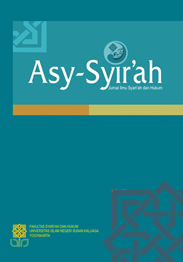Perbandingan GreenKonstitusi, GreenEkonomi, dan Hukum Ekonomi Syariah di Indonesia
Abstract
The rejection of unjustice exploitation to natural environment is central theme of green constitution, green economic, and sharia economic law. The problems, how do comparison of essence and implementation between one and others. In this paper is used study method in law normative. There are two important findings. First, the similarity of essence of green constitution, greeneconomic, and sharia economic law is focus on environment justice (eco-justice). The differences, environment justice under perspective of (a) green constitution means natural environment has to be welfare of people, (b) green economic means natural environment is part of production, distribution, and ethical consumption, and (c) sharia economic law means give the right for future generations to enjoy natural environment. Second, the similarity of implementation challenge faced by three concepts is inconsistention of law. The differences, inconsistention of law faced by (a) green constitution isinconsistension of environments Act with 1945 Constitution, (b) green economic is the loss of unlawfull meaning of lawful term (c) sharia economic law is systemic disobedience by sharia corporation to sharia principles.
Full text article
Generated from XML file
Authors
Yasin, M. N. (2016). Perbandingan GreenKonstitusi, GreenEkonomi, dan Hukum Ekonomi Syariah di Indonesia. Asy-Syir’ah: Jurnal Ilmu Syari’ah Dan Hukum, 50(1), 109–139. https://doi.org/10.14421/ajish.v50i1.166

Asy-Syir'ah : Jurnal Ilmu Syari'ah dan Hukum by Faculty of Sharia and Law, UIN Sunan Kalijaga Yogyakarta is licensed under a Creative Commons Attribution-NonCommercial 4.0 International License.
Authors who publish with this journal agree to the following terms:
- Authors retain copyright and grant the journal right of first publication with the work simultaneously licensed under a Creative Commons Attribution License that allows others to share the work with an acknowledgement of the work's authorship and initial publication in this journal.
- Authors are able to enter into separate, additional contractual arrangements for the non-exclusive distribution of the journal's published version of the work (e.g., post it to an institutional repository or publish it in a book), with an acknowledgement of its initial publication in this journal.
- Authors are permitted and encouraged to post their work online (e.g., in institutional repositories or on their website) prior to and during the submission process, as it can lead to productive exchanges, as well as earlier and greater citation of published work.

